mobile View, to the German Version tap the flag


- Republic of Crimea
- since 1783 Teil part of Russia
- 1921–1945 as Autonomous Soviet Socialist Republic of Crimea part of Soviet Russia
- 1945–1954 as Oblast Crimea part of Soviet Russia
- 1954-1991 part of Soviet Ukraine
- 1991-2014 as Autonomous Republic of Crimea part of Ukraine
- since 2014 as Republic of Crimea part of Russia
• Flag
• Historical Flags
• Crimean Tatars
• Meaning/Origin of the Flag
• Coat of Arms
• Map
• Numbers and Facts
• History
• Origin of the Country's Name
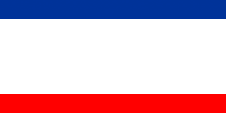
National flag,
ratio = 1:2,
Source, by: Flaggen Enzyklopädie





to 1783,
Flag of the Khanate of Crimea,
Source, by:
World Statesmen



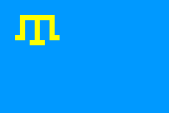
1917–1919,
Government of the Crimean Tatars,
Source, by:
World Statesmen




1918–1921,
Government of the Bolshevists,
Source, by:
World Statesmen



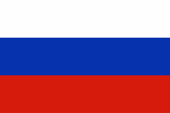
1919–1920,
Flag of the civil government,
ratio = 2:3,
Source, by:
World Statesmen





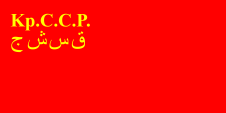
1921–1928,
Flag of the Autonomous Soviet Republic,
ratio = 1:2,
Source, by:
World Statesmen




1929–1937,
Flag of the Autonomous Soviet Republic,
ratio = 1:2,
Source, by:
World Statesmen



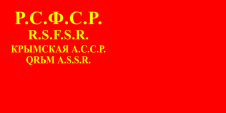
1937–1938,
Flag of the Autonomous Soviet Republic,
ratio = 1:2,
Source, by:
World Statesmen



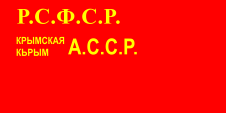
1938–1942, 1944–1945,
Flag of the Autonomous Soviet Republic,
ratio = 1:2,
Source, by:
World Statesmen



look also:
Flag history of the soviet republics of the USSR


Flag of the Crimean Tatars,
Source, by:
Wikipedia (EN)




In the on 24th of September of 1992 adopted blue-white-red flag of Crimea are to see the clours of Russia, to which the Crimean Peninsula belonged to the year 1954 and belongs again since 2014. The flags, which were used in the Soviet era corresponded all to the same pattern as it was intended for the Soviet Autonomous Republics: Between 1923 and 1937 frequently only a single-coloured red bunting with a golden inscription, showing the name of the country. Sometimes only as a shortcut, sometimes the full name, sometimes only in Russian or even multilingual. From about 1937 hammer, sickle and star were sometimes added. The status of Crimea as Autonomous Republic was revoked in 1945 as a result of extensive collaboration of the non-Russian population with the German Empire during the Second World War. The until that valid flag has been abolished. The flag of the Crimean Tatars shows a pale blue bunting. In the upper staff quadrant a sign, which comes from the symbolism of the Golden Horde, a huge Tatar empire, from which the Crimean Tatars descent. Blue is the national colour of the Turks and Mongols respectively as well of the Tatars. The in the Second World War on the side of the German War Might fighting Crimean Tatarian troops uses a similar flag, but the symbol in the upper staff quadrant was red. The denomination "Tatars" held initially just a small Mongolian tribe. During the Mongol Assault in the 12th and 13th century this name was transmitted to all the Mongols. In the 14th century it was maintained for those nations, which arised from the mixture of Mongols, Turks, Volga Fins and Slavs and admit themselves to the Islam.
Source:
Flaggen Enzyklopädie, Die Völker der Erde, Volker Preuß

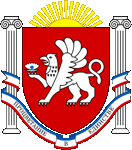
Coat of arms of the Republic of Crimea,
Source: Верховна Рада Республіки Крим,
Public domain, via Wikimedia Commons


Source: CIA World Factbook,
modyfied by: Volker Preuß

Area: 10.069 square miles
Inhabitants: 1.967.200 (2014), thereof 60% Russians, 25% Ukrainians, 14% Crimean Tatars
Density of Population: 195 inh./sq.mi.
Capital: Simferopol (Tataryan: Akmetschet), 338.038 inh. (2014)
official Languages: Russian, Ukrainian, Crimean Tataryan
Currency: Russian currency
Time Zone: GMT + 3 h
Source: Wikipedia (DE)

antiquity · inhabited by Skythians
since 600 B.C. · colonization by Greeks
5th–2nd cent. B.C. · to the Bosporan Empire
110 B.C. · conquered by Greece
63 B.C. · dependent from the Roman Empire
395 · at the partition of the Roman Empire the Chersónesos (Crimea) comes to the East Roman Empire (Byzantium)
ca. 250 · settlement of the Goth
ca. 375 · settlement of the Huns
ca. 650 · settlement of the Chasars, to 890 to the Chasarian Empire
890–990 · to the empire of the Petsheneges
988–989 · Russian conquest under Vladimir, establishment of the Russian Principality of Tmutarakan
1061–1240 · to the Empire of the Kumanes (Kumanian Empire)
1223 · invasion of the Mongols, the Crimea becomes a part of the Empire of the Golden Horde
ca. 1260 · Byzantium loses the last possessions on the Crimea
ca. 1420 · disintegration of the Empire of the Golden Horde
1438 · nascence of the Khanate of Crimea as a leftover of the Empire of the Golden Horde
1475 · the Khanate of Crimea has to recognize the Turkish supremacy
1783 · Russian conquest
1853–1856 · Crimean War (Russia against the Ottoman Empire, England, France and Sardinia)
1914–1918 · First World War, the Crimea is occupied by the Central Mights, withdrawal of the troops after the Peace of Brest-Litovsk, proclamation of the Republic of Kurultai
14th of January 1918 · seizure of power by the Bolshevists
1918–1920 · civil war, initially expulsion of the Bolshevists by General Denikin, one more advance of the Bolshevists, defense by General Wrangel
1921 · erection of the Soviet dictatorship, establishment of the Autonomous Socialistic Soviet Republic of Crimea within the Russian Federative Socialistic Soviet Republic (Soviet Russia)
1939–1945 · Second World War, the Crimea is from 1941 to 1944 occupied by German troops, the Crimean Tatars fight in an own combat unit on the side of the German War Might
1944 · conquest by Soviet troops, all Crimean Tatars get deported to central Asia
1945 · dissolution of the Autonomous Socialistic Soviet Republic of Crimea and incorporation as an oblast (district) into the RSFSR
1954 · annexation of the Krim Oblast to the Ukrainian Soviet Socialist Republic
1967 · the deportation of the Crimean Tatars gets recognised by the parliament of the Soviet Union as injustice, but no right for return
1988 · for the Crimean Tatars is it officially allowed to return on the Crimea
1991 · re-establishment of the Autonomous Republic of Crimea (within Ukraine)
1991 · establishment of the Crimean Tatarian parliament "Milli Mejlis", proclamation of the national independence (not recognized)
January 2014 · coup in Kiev, (not constitutionally compliant change of power), riots
16th of March in 2014 · referendum in the Republic of Crimea, an overwhelming majority votes in favor of a connection to Russia, on 18th of March the parliament of Crimea decides the affiliation to Russia, on 20th of March the parliament of Russia decides the affiliation of the Republic of Crimea to the Russian Federation
Source:
Atlas zur Geschichte,
Die Völker der Erde,
Wikipedia (DE),
Avantgarde für Europa,
Volker Preuß

The designation "Crimea" descends from the times of the Mongol rule. The Mongolian word "Krym" means "fortification". In the antiquity the peninsula was named "Taurian Peninsula" or "Skythian Peninsula", after the colonization by the Greek "Chersónesos", what simply means "peninsula".
Source:
Atlas der wahren Namen,
Wikipedia (DE),
Volker Preuß

Surftip:


![]()


















